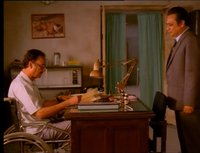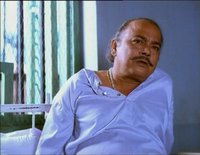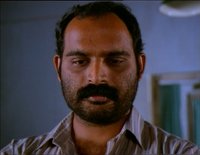from Entertainment Weekly Inside Movies:
http://insidemovies.ew.com/2012/10/19/john-hawkes-the-sessions-able-bodied-actor-disabled-part/
Is John Hawkes in ‘The Sessions’ another able-bodied actor playing a disabled part bound for Oscar?
by Solvej Schou
In The Sessions, opening in theaters this weekend, John Hawkes plays late poet Mark O’Brien, who was paralyzed from the neck down due to polio, and sought, in real life, to lose his virginity by working with a therapeutic sex surrogate. Hawkes is beyond emotionally and physically adept as O’Brien, restricted to laying flat in a huge iron lung, or being wheeled around on a portable cot, his face shifted to the side, his arms pinned to his sides. He’s partially nude at times, staring up at his sex therapist, played by distant-then warm Helen Hunt, and by turns funny, sweet, neurotic and moving. Oscar buzz has been swirling around Hawkes, who told EW at Toronto last month that the role was a challenge, like hungry flies to honey.
If Hawkes is nominated for an Oscar, he’ll join a long line of able-bodied actors and actresses who have been nominated or snagged top acting Academy Awards playing physically disabled – or physically challenged, as others say – roles. While real-life deaf actress Marlee Matlin won a best actress Oscar in 1987 for her part as a deaf pupil in Children of a Lesser God, and Harold Russell, whose hands were amputated after an accident in 1944, nabbed a best supporting actor Oscar trophy in 1947 as a World War II vet in The Best Years of Our Lives, they’re less the norm compared to the long line of able-bodied actors inhabiting those kinds of parts.
There’s Jamie Foxx, who won a best actor Oscar in 2005 as piano-playing and blind R&B impresario Ray Charles in the biopic Ray, Al Pacino, who won an Oscar in 1993 as a blind lieutenant colonel in Scent of a Woman, and Patty Duke, who snatched up a best supporting actress Oscar in 1963 as blind and deaf heroine Helen Keller. Audrey Hepburn was nominated for a lead actress Oscar in 1968 as a blind woman terrorized by criminals in Wait Until Dark.
Among the best known able-bodied performers inhabiting physically disabled starring roles is Daniel Day-Lewis in My Left Foot as true life writer and painter Christy Brown, a smart, creative quadriplegic man born with cerebral palsy, and only able to control his left foot. Day-Lewis was fiercely realistic in the movie, and won a best actor Oscar for it in 1990. That same year, in 1990, Tom Cruise grabbed an Oscar nomination for Born On the Fourth of July, playing real-life Vietnam vet Ron Kovic, who used a wheelchair after becoming paralyzed from the chest down while wounded during the war. Jon Voight also touched on a political and emotional nerve playing a paraplegic Vietnam vet in Coming Home, which won him an Oscar in 1979.
What do actors and actresses within the physically challenged community think about this longtime trend, including the possibility of Hawkes also being in line for an Oscar nod? The response ranges from support of able-bodied performers taking on challenging roles, to the need for more acting opportunities for actually disabled people. The Sessions director Ben Lewin is himself a polio survivor, and did hire some physically disabled actors for the film.
“I do not speak for all performers with disabilities – I’m a double leg amputee for 35 years, after my accident – but John Hawkes’ performance is astounding, and Helen Hunt’s as well. Of the movies I’ve seen so far this year, I think he’s in Oscar contention, and her as well,” CSI: Crime Scene Investigation actor Robert David Hall, chairman of acting union SAG-AFTRA’s Performers with Disabilities Committee, told EW.com. “This is a truthful and moving movie. Ben is a post polio person, and that’s pretty important. I know Ben thought about this when he was beginning to cast the movie. I just ask that people with disabilities are interviewed and auditioned. … There’s always an Oscar buzz if you play a physically disabled person. Thing is, you have to do it well, and affect people. Jon Voight’s portrayal in Coming Home opened people’s eyes for those with disabilities. It’s also a two-edged sword. On one hand I want portrayals to be accurate and honest, whether by a disabled or able-bodied actor, and on the other hand, I want people with disabilities to have more opportunities.”
Hall pointed out that 20 percent of Americans are identified as physically disabled compared to a minute percentage of actors working in the business.
“There’s a huge disconnect. There are a lot of talented people with disabilities trying to make it in the business,” he said. “I like to think of The Sessions as something that will increase awareness. Would it be better without John Hawkes? I don’t think so. It’s a tough business for anyone out there, really. I’m just proud as a human being to say this is a great movie. … There’s not a lot of fake emotion. There’s not a lot of pity. The thing that gets me the most when I see someone disabled in a movie is that they’re portrayed as either super strong or super weak. The humanity is drained out of them. We care about the same things as other people. Having a good time, sexuality. When I worked in radio, nobody cared I had artificial legs.”
For Cindy Allen, who was born with cerebral palsy, uses a wheelchair, and has been a working actress for 30 years, appearing on shows such as ER and Chicago Hope, as well as in movies, it’s also a matter of opportunities, access and talent. Allen’s a longtime member of California’s Media Access Office, which was established in 1980 in part by the California Governor’s Committee on Employment of People with Disabilities to provide a liaison between performers with disabilities and the media and entertainment industry. However, the office was temporarily discontinued this past week, and folded into the larger umbrella of California’s Employment Development Department, putting more strain on physically disabled actors having help finding jobs, Allen said.
“Playing a disabled role is not about getting an Oscar, it’s about dealing with a disability. Someone without a disability, no matter how much time training, it won’t be the same,” said Allen. “I’m not taking anything away from his [John Hawkes’] acting ability, but there are thousands of equally qualified disabled actors out there who can bring more authenticity to the role. I have been on so many auditions, but people say, ‘You look too disabled.’ What does that mean? Either you want authenticity, or you don’t. … To me, it’s like, there’s no way today, in 2012, that any role that was written for someone who is African-American would be played by a person in black face. It’s the same thing. We’re just going through it 30 years later than Sidney Poitier. There are equally talented people, who just don’t have the same star power. … All I’m asking for as a disabled actor is to have the opportunity first.”






